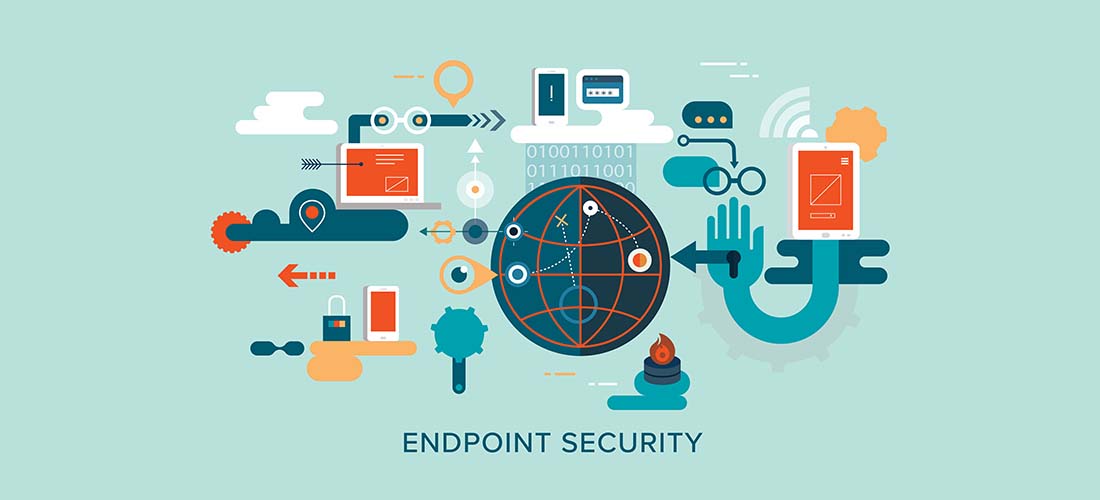Navigating the Complexities of Modern Endpoint Security
 Solomon Achugwoh
Solomon Achugwoh
The digital landscape is constantly evolving, and with it the complexity of threats we face. Businesses face a constant barrage of cyberattacks with traditional antivirus software once considered a solid defense, struggling to keep pace with increasingly sophisticated cyberattacks. This has led to the rise of modern endpoint security solutions.
Endpoint security is an approach to network security that prevents endpoint devices from been attacked or minimize the attack against this device. It requires endpoint devices to comply with specific criteria like (patch level, specific software installed) before they are granted access to a network. This criterion varies among several organization for endpoint to access resources.
Endpoint security management system are tools that help on a mass scale protect endpoint. Endpoint security system works in client server model where you can centrally manage endpoints. It has an application that resides on endpoint that is centrally managed either through console application or website. A centrally managed server hosts a security program, and an accompanying client program runs on each endpoint. This client program or agent, sends information such as logs, local machine data, and malware scan results to the server. With the server EDR program, the server administrator analyses this information to defend endpoints from malware and additional threats.
Endpoint detection and response (EDR)
Antivirus works by protecting a specific endpoint and prevent viruses from causing damages to the endpoint but EDR goes a step further than that. EDR has capabilities associated with it, which are deploying devices with network configurations, automatically quarantine or block non-compliant endpoints. EDR solutions have the ability to distribute patches to all of the endpoints in a networked environment ensuring a particular end-device without a patch level or particular software installed would be block from being able to access resources on the network until it gets to that requirements, requisites or prerequisites that are needed. EDR will does things like zero-day OS updates. It also provides continuous monitoring, automatic policy creation and patching, as well as enforcement of security policies across all the endpoints in a network environment. EDR has become an essential part of cybersecurity strategy. EDR is mostly concerned with proactively detecting threats associated with endpoint when they occur and responding to them in real time.
How it works:
Real-time monitoring: EDR continuously monitors endpoint activity, detecting suspicious behavior even if it doesn't match a known signature.
Improved threat hunting: EDR allows security teams to proactively search for potential threats within their network.
Improved threat detection: By correlating data from different sources, XDR can proactively search for potential threats within their network and identify complex threats that might be missed by individual tools.
Security teams are usually overwhelmed with triaging from different tools. EDR integrate into the already existing work flow and prioritize incidents, presenting this relevant information in a friendly interface. Data from EDR needs to be fed to other management platforms like SIEM, SOAR tools or XDR platform.
Extended Detection and Response (XDR): Expanding the Scope of Detection and Response
According to FireEye on an average the dwell time an attacker spends on a network is 56 days.
EDR and XDR are tools used to minimize the dwell time by detecting and mitigating to threat quicker. EDR focuses on endpoint while XDR focuses on other critical area of network like cloud applications and firewall. Endpoint are critical part of the attack surface but they are small part of what makes the network. Large network has IOT devices, cloud apps and firewall etc.
Extended Detection and Response (XDR) is defined by Gartner as “a SaaS-based, vendor-specific, security threat detection and incident response tool that natively integrates multiple security products into a cohesive security operations system that unifies all licensed components.
XDR can take in telemetry data make a decision based on supervised learning it has received and respond to the relevant device to mitigate the risk on network. XDR ingest data from multiple security sources in order to correlate telemetry data that would be difficult to find manually. XDR gives the capability to respond to threat manually or automatically.
Here are some key capabilities of XDR:
Data aggregation and correlation: XDR collects and correlates data from various security tools and sources, such as endpoint detection and response (EDR), network detection and response (NDR), cloud security platforms, and more. This enables a more holistic view of an organization's security posture.
Advanced threat detection: XDR leverages machine learning, behavioral analysis, and threat intelligence to detect known and unknown threats in real-time. It can identify and alert on suspicious activities, malware, and other potential security incidents.
Automated investigation: XDR automates the investigation process by analyzing the collected data and providing contextual information about potential threats. This helps security analysts to quickly understand the nature, scope, and impact of a security incident.
Automated response: XDR enables security teams to respond to security incidents more efficiently by automating response actions, such as isolating compromised devices, blocking malicious IP addresses, and remediating vulnerabilities.
Centralized management and orchestration: XDR provides a centralized console for security teams to manage and orchestrate their security tools and processes. This helps to streamline security operations, reduce response times, and improve overall security effectiveness.
Embracing the Future of Endpoint Security: Unified Endpoint Management (UEM)
IT teams no longer need to manage and secure mobile devices from separate platforms. Workers today may use a personal smartphone, a shared tablet and a corporate-issued device, they may also interact with non-standard endpoints. In any case, the devices can be managed by a single UEM solution for secure access, reduced risk and a satisfying end-user experience, helping build a zero-trust strategy. Unified Endpoint management platform enables a single pane of glass.
Traditional mobile device management solutions were built for a simpler time. When we started to get more and more device types, namely iOS and Android, there became a need for a centralized management solution that could handle everything, and that's when MDM solutions started popping up. UEM solutions are designed to manage and secure a wide range of devices, including desktops, laptops, smartphones, tablets, IoT devices, servers and even cloud-based endpoints. UEM solutions integrate various endpoint management and security tools, such as Mobile Device Management (MDM), Mobile Application Management (MAM), Advanced Detection and Response (ADR), Endpoint Detection and Response (EDR), and more, into a single platform. This enables organizations to have a more holistic view of their security posture and respond to security incidents more effectively.
Trends that shaped Unified Endpoint Management (UEM)
The emergence of Unified Endpoint Management (UEM) can be attributed to several key trends that have shaped the modern IT landscape:
Rapid growth of mobile devices: The widespread adoption of smartphones, tablets, and other mobile devices has led to an increase in the number of endpoints that organizations need to manage and secure. UEM solutions help organizations to manage these devices alongside traditional endpoints.
BYOD (Bring Your Own Device): The rise of the BYOD trend has made it necessary for organizations to manage and secure a growing number of personal devices that are being used for work purposes. UEM solutions provide a centralized platform for managing and enforcing policies on both corporate-owned and personal devices.
Cloud computing and SaaS applications: The shift towards cloud-based services and Software-as-a-Service (SaaS) applications has led to a greater need for managing and securing remote endpoints. UEM solutions provide the necessary tools and capabilities to manage and secure endpoints, regardless of their location.
Increased security concerns: As cyber threats continue to evolve and become more sophisticated, organizations are increasingly focused on protecting their endpoints. UEM solutions offer advanced security features, such as threat detection, response, and remediation, to help organizations protect their assets and data.
Need for centralized management: With the growing complexity of IT environments, organizations are seeking solutions that provide a centralized platform for managing and orchestrating their endpoint management and security tools. UEM solutions offer a single console for managing all endpoints, which helps to streamline operations and reduce the administrative burden.
Compliance and regulatory requirements: The need to comply with various regulations and standards, such as GDPR, HIPAA, and PCI DSS, has led organizations to seek solutions that can help them meet these requirements. UEM solutions offer capabilities that help organizations to enforce policies, monitor compliance, and maintain a secure and compliant environment.
In summary, while Unified Endpoint Management (UEM) offers significant benefits, it's not necessarily an upgrade to XDR and EDR. Instead, it complements and extends XDR and EDR functionality by taking a holistic approach to endpoint security and management. UEM offers a more comprehensive and efficient way to protect your organization in today's ever-evolving threat landscape. While XDR and EDR focus primarily on threat detection and response, UEM goes beyond by providing centralized management and control over diverse endpoint devices, including desktops, laptops, mobile devices, and IoT devices. By adopting a UEM approach, organizations can enhance their endpoint security posture, streamline operations, and mitigate the risks associated with modern cyber threats.
Subscribe to my newsletter
Read articles from Solomon Achugwoh directly inside your inbox. Subscribe to the newsletter, and don't miss out.
Written by

Solomon Achugwoh
Solomon Achugwoh
I am a cyber security strategist involved in security implementation and cyber awareness across individual and organization level. I am a strong advocate of information security ethics on the part of people using technology. I have strong interest in incident response and vulnerability assessment and passionate about information technology as a whole. I spend my spare time watching football or participating in a sporting activity.